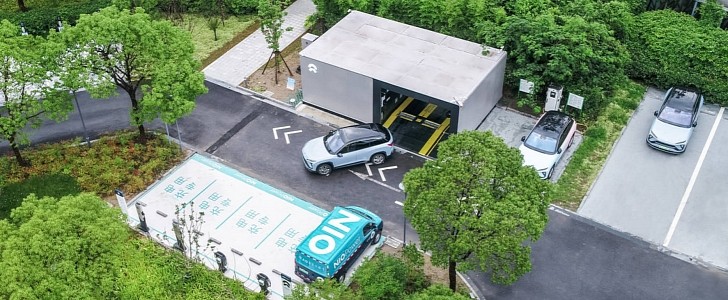NIO may be on the verge of something exciting. The company currently has a little more than 500 battery swap stations. If each of them has solar panels, they can become mini solar power plants. That’s precisely what the company will do with the help of Unisun Energy.
Both companies have signed a deal on October 19 that will allow Unisun to install solar panels on top of all NIO Power Swap Station 2.0 – that’s the official name of its second-generation battery swap stations. According to CNEVPost, each of these stations would have an output of 100 kW.
If you consider that NIO plans to have 4,000 battery swap stations by 2025 – 3,000 of which in China – that means the stations will deliver 300 MW of power by then. That’s enough energy to power around 300,000 houses.
That may not seem like much, but the potential of the idea makes it so attractive. Apart from charging the battery packs with solar energy and sparing the power grid from that demand, these stations can also store the electricity. Thus, in case of a power shortage for any reason, the NIO Power Swap Stations may help provide energy in the areas in which they are distributed.
That will give NIO not only a new revenue stream: it will also make these stations present public value. These massive power banks (and mini-power plants at the same time) will become assets for the regions in which they are located.
As NIO expands its battery swap network, the idea should spread as well. Competitors such as Geely will like it and try to use it in their own stations, which will create relevant energy backups all around China.
We hope that NIO follows the idea to place solar panels on the roof of its international battery swap stations as well. Considering 1,000 of them will be located abroad, the countries that have them may also like the idea of having extra power coming from renewable sources.
If you consider that NIO plans to have 4,000 battery swap stations by 2025 – 3,000 of which in China – that means the stations will deliver 300 MW of power by then. That’s enough energy to power around 300,000 houses.
That may not seem like much, but the potential of the idea makes it so attractive. Apart from charging the battery packs with solar energy and sparing the power grid from that demand, these stations can also store the electricity. Thus, in case of a power shortage for any reason, the NIO Power Swap Stations may help provide energy in the areas in which they are distributed.
That will give NIO not only a new revenue stream: it will also make these stations present public value. These massive power banks (and mini-power plants at the same time) will become assets for the regions in which they are located.
As NIO expands its battery swap network, the idea should spread as well. Competitors such as Geely will like it and try to use it in their own stations, which will create relevant energy backups all around China.
We hope that NIO follows the idea to place solar panels on the roof of its international battery swap stations as well. Considering 1,000 of them will be located abroad, the countries that have them may also like the idea of having extra power coming from renewable sources.











